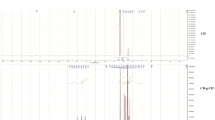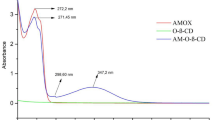Abstract
In the present study, we have prepared highly soluble MSZ-β-Cyclodextrin (β-CD). UV–Vis method was employed to approve the successful formation of the inclusion complex where the MSZ has been encapsulated by the hydrophobic cavity of β-CD. MSZ-β-CD were then encapsulated into positively charged biodegradable chitosan (MSZ-CDs-CS) nanoparticles. The MSZ-β-CD complex was prepared at 1:1 stoichiometry and characterized by UV–Vis, FTIR, 1HNMR and SEM analysis. Phase-solubility analysis showed AL-type diagram, according to the Higuchi and Connors method. The estimated apparent stability constant (K1:1), was obtained (Kstab = 696.46 M−1) at 25 °C. Antioxidant activity and release behavior of the MSZ-loaded β-CD-CS was investigated. The IC50 value for MSZ/CD-CS was estimated based on their inhibition percent–concentration curves using DPPH assay. Release behavior of the free MSZ and inclusion complexes were compared at a similar concentration and at pH = 5.20 and 2.6. Molecular modeling of the inclusion complex of β-CD and MSZ was optimized at B3LYP/3-21G computational level using the Gaussian 09 program to detect probable incorporation of the host–guest molecule. The experimental results approved the compound of MSZ complexes with β-CD also these promising strategy for the clinical application and delivery system of MSZ in the future.










Similar content being viewed by others
References
Tang P, Sun Q, Zhao L, Pu H, Yang H, Zhang SH, Gan R, Gan N, Li H (2018) Mesalazine/hydroxypropyl-β-cyclodextrin/chitosan nanoparticles with sustained release and enhanced anti-inflammation activity. Carbohyd Polym 198:418–425
Seifirad S, Karami H, Shahsavari Sh, Mirabbasi F, Abedin Dorkoosh F (2016) Design and characterization of mesalamine loaded nanoparticles for controlled delivery system nanomed. Res J 1(2):97–106
Dodziuk H (ed) (2006) Cyclodextrins and their complexes. Wiley-VCH Verlag GmbH & Co, Weinheim. https://doi.org/10.1002/3527608982
Wupper S, Luersen K, Rimbach G (2021) Review cyclodextrins, natural compounds, and plant bioactives—a nutritional perspective. Biomolecules 11(3):401
Saquib Hasnain M, Kumar Nayak A (2018) Chitosan as responsive polymer for drug delivery applications in stimuli responsive polymeric nanocarriers for drug delivery applications. Woodhead Publ Ser Biomater 1:581–605
Masoud Kasiri B (2019) Application of chitosan derivatives as promising adsorbents for treatment of textile wastewater. In: The impact and prospects of green chemistry for textile technology, pp 417–469
Hanauer S, Schwartz J, Robinson M, Roufail W, Arora S, Cello J et al (1993) Mesalamine capsules for treatment of active ulcerative colitis: results of a controlled trial. Am J Gastroenterol 88:1188–1197
Malakzadeh Sh, Alizadeh N (2020) Antioxidant, antibacterial and anti-cancer activities of β-and γ- CDs/curcumin loaded in chitosan nanoparticles. Int J Biol Macromol S0141–8130(19):36535–36543
Malakzadeh Sh, Alizadeh N (2020) Changes in chemical stability and bioactivities of curcumin by forming inclusion complexes of beta- and Gama-cyclodextrins. J Polym Res 2:1–13
De Carvalho LB, Burusco KK, Jaime C, Venancio T, de Carvalho AFS, Murgas LDS et al (2018) Complexes between methyltestosterone and beta-cyclodextrin for application in aquaculture production. Carbohyd Polym 179:386–393
Mura P (2015) Analytical techniques for characterization of cyclodextrin complexes in the solid state: a review. J Pharm Biomed Anal 113:226–238
Wei YQ, Zhang J, Zhou Y, Bei WY, Li Y, Yuan QP (2017) Characterization of glabridin/hydroxypropyl-beta-cyclodextrin inclusion complex with robust solubility and enhanced bioactivity. Carbohyd Polym 159:152–160
Trapani A, Garcia-Fuentes M, Alonso MJ (2008) Novel drug nanocarriers combining hydrophilic cyclodextrins and chitosan. Nanotechnology 19(18):185101
Wua C-S, Hsu Y-C, Liao H-T, Ca Y-X (2015) Antibacterial activity and in vitro evaluation of the biocompatibility of chitosan-based polysaccharide/polyester membranes. Carbohyd Polym 134:438–447
Rabus J, Pellegrinelli R, Abi Khodr A, Bythell B, Rizzo T, Carrascosa E (2021) Unravelling the structures of sodiated β-cyclodextrin and its fragments. Phys Chem Chem Phys 23:13714–13723. https://doi.org/10.1039/d1cp01058a
Rachmawati H, Edityaningrum CA, Mauludin R (2013) Molecular inclusion complex of curcumin–β-cyclodextrin nanoparticle to enhance curcumin skin permeability from hydrophilic matrix gel. AAPS Pharm Sci Technol 14:1303–1312
Thambiraj S, Hema S, Ravi Shankaran D (2018) Functionalized gold nanoparticles for drug delivery applications. Mater Today Proc 5(8):16763–16773. https://doi.org/10.1016/j.matpr.2018.06.030
Tran CD, Makuvaza J, Munson E, Bennett B (2017) Biocompatible copper oxide nanoparticle composites from cellulose and chitosan: facile synthesis, unique structure, and antimicrobial activity. ACS Appl Mater Interfaces 9:42503–42515
Liu M, Dong L, Chen A, Zheng Y, Sun D, Wang X, Wang B (2013) Inclusion complexes of quercetin with three β-cyclodextrins derivatives at physiological pH: spectroscopic study and antioxidant activity. Spectrochim Acta Part A Mol Biomol Spectrosc. https://doi.org/10.1016/j.saa.2013.07.008
Yadav AV, Yada VB (2008) Improvement of physicochemical properties of mesalamine with hydrophilic carriers by solid dispersion (kneading) method. Res J Pharm Technol 1:422–425
Natella F, Nardini M, Di Felice M, Scaccini C (1999) Benzoic and cinnamic acid derivatives as antioxidants: structure–activityrelation. J Agric Food Chem 47(4):1453–1459
Jinxia L, Huizhi Z, Yanyan Y, Shumao S (2016) Study of the inclusion complex and antioxidating activity of Wogonin with β-cyclodextrin and hydroxypropyl-cyclodextrin. J Incl Phenom Macrocycl Chem 84:115–120
Yuan Z, Ye Y, Gao F (2013) Chitosan-graft-β-cyclodextrin nanoparticles as a carrier for controlled drug release. Int J Pharm 446(1–2):191–198
Agnihotri SA, Mallikarjuna N, Aminabhavi TM (2004) Recent advances on chitosan-based micro- and nanoparticles in drug delivery. J Control Release 100(1):5–28
Yadav P, Bandyopadhyay A, Chakraborty A, Sarkar K (2018) Enhancement of anticancer activity and drug delivery of chitosan-curcumin nanoparticle via moleculardocking and simulation analysis. Carbohyd Polym 182:188–198
Ma M, Sun T, Xing P, Li Z, Li S, Su J, Chu X, Hao A (2014) A supramolecular curcumin vesicle and its application in controlling curcumin release. Colloids Surf A. https://doi.org/10.1016/j.colsurfa.2014.06.043
Acknowledgements
We acknowledge the financial support from University of Guilan and University campus 2, University of Guilan (Rasht, Iran).
Author information
Authors and Affiliations
Corresponding author
Ethics declarations
Conflict of interest
The authors declare that they have no competing interest.
Additional information
Publisher's Note
Springer Nature remains neutral with regard to jurisdictional claims in published maps and institutional affiliations.
Rights and permissions
About this article
Cite this article
karpour, M., Alizadeh, N. Physicochemical characterization and in vitro evaluation of mesalazine/β-cyclodextrin inclusion complex loaded into chitosan nanoparticles. Polym. Bull. 80, 3021–3039 (2023). https://doi.org/10.1007/s00289-022-04204-3
Received:
Revised:
Accepted:
Published:
Issue Date:
DOI: https://doi.org/10.1007/s00289-022-04204-3




